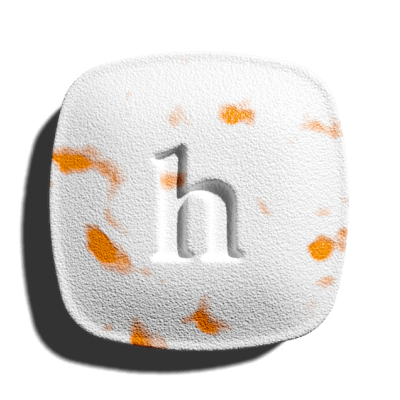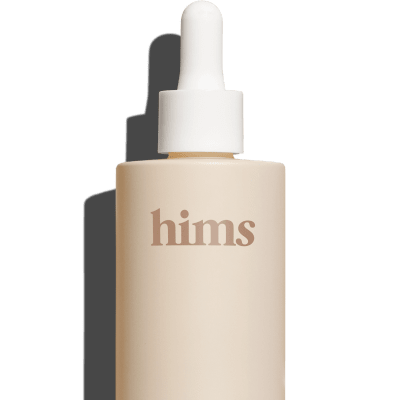Content
FDA approved for more than 25 years
What Is DHT? DHT & Hair Loss Explained

If you’ve started to show signs of male pattern baldness, you might’ve read that it’s caused by a hormone called dihydrotestosterone, or DHT. But what exactly is DHT hair loss, and can you stop it from getting worse?
Also called androgenetic alopecia (or sometimes androgenic alopecia), male pattern hair loss is the most common type of hair loss in men. It’s characterized by a receding hairline or thinning hair on the crown of the head, which usually gets worse over time.
Male pattern hair loss is caused by a combination of genetic factors and DHT. If you come from a long line of balding men, you’re more likely to go bald yourself.
The good news? There are some ways to counteract the effects of DHT and slow down male pattern hair loss. You might even be able to regrow some of the hair you’ve lost.
What is DHT hair loss, and what can you do about it? We’ll explain what DHT is, its effects on healthy hair growth, and remedies for genetic thinning.
Content
What Is DHT (Dihydrotestosterone)?
DHT is an androgen (aka male hormone) produced by the body as a byproduct of testosterone.
Androgens produce male characteristics, like bone structure and a deep voice. They also contribute to several aspects of your sexual health and function.
Produced in the testes, testosterone is men’s primary sex hormone. An enzyme called 5-alpha reductase (or 5AR) converts a small percentage of testosterone into DHT in your skin, liver, and prostate gland.
Testosterone is also converted to DHT by the 5AR enzyme in your scalp, including in your hair follicles.
What Does DHT Do?
The DHT hormone plays a significant role in sexual development before and during puberty.
Before you’re born, DHT helps develop your penis and scrotum. As you enter adolescence, it promotes the growth of facial hair, body hair, and pubic hair.
Most men have much higher levels of testosterone than DHT. According to research, the normal level of DHT in your bloodstream is only about a tenth of your testosterone.
But DHT is pretty potent, which is why it can have a significant effect on your body. Let’s look at what happens when DHT levels are too high or too low.
High DHT Symptoms
While DHT is important, you can have too much of a good thing.
High DHT doesn’t always cause issues, but it’s associated with specific health conditions like:
Benign prostatic hyperplasia (BPH). High DHT levels may lead to an enlarged prostate gland. BPH can cause sexual dysfunction and urinary issues.
Prostate cancer. High DHT levels are associated with prostate cancer.
Polycystic ovarian syndrome (PCOS). This hormonal imbalance can occur in people with ovaries.
More famously (and probably why you’re reading this), high levels of DHT are a culprit of male pattern hair loss. We’ll get into why DHT causes hair loss in the next section.
Low DHT Symptoms
As mentioned, DHT has some crucial jobs. Low DHT is associated with certain health conditions, including:
Delayed puberty (in children). Since DHT plays a role in puberty, low levels of DHT can delay puberty.
5-alpha reductase deficiency. Low DHT can be a symptom of low 5AR, which can affect genital development.
Low testosterone (male hypogonadism). Low testosterone levels often lead to low DHT. When left untreated, this can affect sex drive, muscle mass, energy levels, fertility, and more.
If you think you might have low DHT levels or a hormonal imbalance, it’s a good idea to consult a healthcare professional.
All about hair, here
How Does DHT Cause Hair Loss?
DHT causes hair loss by miniaturizing (shrinking) hair follicles around the hairline and top of the scalp.
Hair miniaturization sounds complicated, but it’s actually pretty simple. Every hair on your scalp, face, and body grows as part of a three-phase cycle known as the hair growth cycle.
Anagen phase. In the first phase, each hair grows to its full length.
Catagen phase. After reaching the end of the growth phase, the hair stops growing and becomes dormant.
Telogen phase. In the telogen phase, the hair falls out and is eventually replaced by a new strand.
This continuous process lets you maintain a full head of hair even as old hairs are shed on a regular basis.
DHT Hair Loss and the Hair Growth Cycle
When DHT miniaturizes hair follicles, it shortens the anagen phase and prevents hair from growing properly.
Over time, hairs affected by DHT get thinner and shorter, eventually resulting in hair that’s unable to grow.
This process usually starts at the hairline and crown, resulting in the classic receding hairline or bald patch that many men notice as a first sign of hair loss.
Why DHT Affects People Differently
Just like your genes play a major role in determining your height, hair color, eye color, and other physical characteristics, they also have a big influence on how susceptible you are to male pattern baldness.
Experts think some men’s hair follicles are more sensitive to DHT than others, meaning they miniaturize and stop growing new hairs faster when DHT attaches to receptors in the scalp.
Research also suggests that guys with male pattern baldness have higher average levels of DHT and greater concentrations of androgen receptors in the scalp.
This means that if you’re very susceptible to hair loss, you may not just be more sensitive to the effects of DHT than your peers — your body might also be more prone to converting testosterone into DHT.
This type of hair loss doesn’t only affect men. Women also make small amounts of testosterone and, therefore, DHT. In women, this is called female pattern hair loss or female pattern baldness.
DHT vs. Testosterone
DHT and testosterone are both androgen hormones. But their functions within your body are different.
For guys, testosterone is a critical hormone for well-being throughout all life stages, including childhood, puberty, and adulthood. A healthy level of testosterone helps you maintain a normal sex drive, muscle mass, and bone health. Testosterone is also vital for mental function, red blood cell production, and energy levels.
Like testosterone, dihydrotestosterone is important during childhood and puberty, but it doesn’t play as big of a beneficial role for adult men.
The major effects of DHT in adulthood include contributing to prostate enlargement and causing pattern hair loss.
What Causes DHT to Increase?
If you’re genetically predisposed to DHT sensitivity, increased DHT levels could elevate your risk of pattern hair loss. It’s a bummer, but it’s a part of life for many men.
So, what could make your DHT levels go up? Well, since DHT is produced as a byproduct of testosterone, anything that contributes to higher testosterone levels is also likely to contribute to more DHT.
You can increase testosterone levels through healthy lifestyle habits, like nutrition, sleep, and exercise. There isn’t any research showing that these habits cause any noticeable increase in hair shedding.
Medications Affecting Testosterone and DHT
However, any medications that increase the amount of testosterone in your body could cause hair loss.
For example, testosterone injections used to treat low testosterone could make your DHT levels increase sharply, causing your hair loss to become more severe.
This is something you’ll want to talk about with your healthcare provider, particularly if you have low testosterone and use medication to treat it.
Will you join thousands of happy customers?
4.5 average rating
So, what can you do about DHT hair loss? Since DHT is the main hormone responsible for hair loss in men, the most effective way to slow down and prevent hair loss is to block DHT.
Currently, the most effective way to reduce DHT levels is with medication like finasteride. You can also try research-backed hair products containing minoxidil or saw palmetto.
Finasteride
Finasteride (generic for Propecia®) is a prescription medication approved by the FDA (U.S. Food and Drug Administration) to treat male pattern baldness.
Finasteride is a 5-alpha reductase inhibitor (or 5ARI). In other words, it blocks the effects of the enzyme that converts testosterone to DHT. As a result, finasteride drastically lowers the total amount of DHT your body produces.
Research from clinical trials suggests that a normal dose of finasteride can lower DHT levels by 70 percent — which is enough to slow down, stop, or reverse hair loss in most men.
This reduction in DHT levels means your hair follicles are no longer under constant attack. With continued use, your balding should slow down, and you might even notice hair regrowth.
Most men start to see improvements after about three months of daily use, with the most significant results after a year.
Minoxidil
Minoxidil doesn’t block DHT. But if you have DHT-related hair loss, it can be a helpful tool to have in your arsenal.
Minoxidil is an over-the-counter, topical hair loss treatment. It works by pushing follicles into the growth phase of the hair cycle, meaning hair shafts grow for a longer period before falling out.
It also stimulates blood flow in your scalp, so hair follicles get the nutrients they need to function optimally.
Minoxidil isn’t just used for male pattern baldness — you can also use it to address other causes of hair loss.
We offer minoxidil foam and minoxidil liquid solution, both of which can be bought without a prescription. Just apply it to your scalp every day.
You can even combine minoxidil and finasteride to boost your hair-growth strategy. We have a dual-action topical finasteride & minoxidil spray that offers the best of both worlds.
DHT-Blocking Shampoo
If you’ve ever spent time browsing the men’s shampoo section of your local drugstore, you’ve likely seen shampoos marketed as DHT blockers.
These products contain active ingredients that wash away excess DHT from your scalp, which may help protect against hair loss.
One popular ingredient in hair-thickening shampoo is saw palmetto. This herbal substance may prevent DHT buildup on your scalp and protect your hair follicles.
Some research suggests that pumpkin seed oil is a 5-alpha reductase inhibitor that reduces DHT levels in the scalp, but more research is needed to verify this.
Another option is ketoconazole, a topical antifungal medication linked to improvements in hair growth in men. (It’s not known to lower DHT levels, though).
Hair growth shampoos aren’t as effective as finasteride, so they’re best used as one part of your haircare routine, not on their own.
Most men don’t experience any side effects from DHT blockers — unless you consider thicker, fuller hair a side effect, of course. However, a small percentage of men who use DHT blockers like finasteride do experience some side effects.
These can range from a mild increase in testosterone levels to sexual function issues like erectile dysfunction (ED) or reduced sex drive.
Potential side effects of finasteride include:
Higher testosterone levels. Since finasteride stops the conversion of testosterone to DHT, it may contribute to slightly higher testosterone levels. In a 2003 study, researchers found that long-term use of finasteride was associated with a modest increase in testosterone.
Lower sex drive. Most of the time, finasteride has no positive or negative effect on sex drive. But for a small number of men, it might result in a reduced interest in sex.
Weak erections. This is another rare side effect that affects only a small number of finasteride users. Some men report getting less “morning wood” while using finasteride, possibly due to lower levels of DHT.
These side effects might seem off-putting. But the reality is, the vast majority of men who use finasteride DHT blockers don’t get serious side effects.
To put things in perspective, a 2012 study of Japanese men found that out of the 3,177 who used finasteride, only 23 had adverse reactions. Even at five times the regular dosage for preventing hair loss, finasteride side effects are rarely reported.
It’s also worth noting that in the rare event of sexual side effects occurring, they’ll almost always stop once you stop taking finasteride. It’s very uncommon for any negative effects to continue if you don’t actively take a DHT blocker.
Hair loss treatments, delivered
The Bottom Line on DHT and Hair Loss
DHT plays a major role in male pattern baldness. It’s the hormone responsible for that receding hairline you’re starting to notice, as well as other common signs of hair loss like a bald patch at your crown or diffuse thinning on your scalp.
If you’re starting to notice male pattern baldness, reducing your DHT levels is the most effective way to slow down, stop, or reverse hair loss.
Keep the following in mind when considering DHT hair loss:
Finasteride is your most effective option for reducing DHT levels. This medication blocks DHT at its source by inhibiting the enzyme that creates it. It’s easy to use and can be taken once a day to lower DHT production.
DHT-blocking shampoo is also helpful. Look for active ingredients like saw palmetto, which may block DHT at the scalp level. DHT-blocking shampoo is most effective when used with finasteride.
Other non-DHT treatments can also help with hair loss. For example, the topical medication minoxidil works by stimulating hair growth on the scalp.
We offer finasteride and other medications for hair loss online as part of our range of hair loss treatments for men.
Interested in getting started? Do a quick hair loss consultation to learn about your best options for preventing hair loss, stimulating hair growth, and maintaining a fuller, thicker head of hair.
11 Sources
- Badri T, et al. (2024). Minoxidil. https://www.ncbi.nlm.nih.gov/books/NBK482378/
- Hoover E, et al. (2022). Physiology, Hair.https://www.ncbi.nlm.nih.gov/books/NBK499948/
- Ho CH, et al. (2022). Androgenetic Alopecia. https://www.ncbi.nlm.nih.gov/books/NBK430924/
- Kinter KJ, et al. (2022). Biochemistry, Dihydrotestosterone. https://www.ncbi.nlm.nih.gov/books/NBK557634/
- Mysore V. (2012). Finasteride and sexual side effects. https://www.ncbi.nlm.nih.gov/pmc/articles/PMC3481923/
- National Library of Medicine. (2017). 5-alpha reductase deficiency. https://medlineplus.gov/genetics/condition/5-alpha-reductase-deficiency/
- National Library of Medicine. (2021). Could you have low testosterone?. https://medlineplus.gov/ency/patientinstructions/000722.htm
- PROPECIA- finasteride tablet, film coated. (2021). https://www.accessdata.fda.gov/spl/data/3c8dff7e-41ab-46db-bacf-c41cc237f9d9/3c8dff7e-41ab-46db-bacf-c41cc237f9d9.xml
- Roerhborn CG, et al. (2003). Effects of finasteride on serum testosterone and body mass index in men with benign prostatic hyperplasia. https://pubmed.ncbi.nlm.nih.gov/14624915/
- Sato A, et al. (2012). Evaluation of efficacy and safety of finasteride 1 mg in 3177 Japanese men with androgenetic alopecia. https://pubmed.ncbi.nlm.nih.gov/21980923/
- Zito PM, et al. (2022). Finasteride. https://www.ncbi.nlm.nih.gov/books/NBK513329/
Editorial Standards
Hims & Hers has strict sourcing guidelines to ensure our content is accurate and current. We rely on peer-reviewed studies, academic research institutions, and medical associations. We strive to use primary sources and refrain from using tertiary references. See a mistake? Let us know at [email protected]!
This article is for informational purposes only and does not constitute medical advice. The information contained herein is not a substitute for and should never be relied upon for professional medical advice. Always talk to your doctor about the risks and benefits of any treatment. Learn more about our editorial standards here.
Knox Beasley, MD
Dr. Knox Beasley is a board certified dermatologist specializing in hair loss. He completed his undergraduate studies at the United States Military Academy at West Point, NY, and subsequently attended medical school at Tulane University School of Medicine in New Orleans, LA.
Dr. Beasley first began doing telemedicine during his dermatology residency in 2013 with the military, helping to diagnose dermatologic conditions in soldiers all over the world.
Dr. Beasley is board certified by the American Board of Dermatology, and is a Fellow of the American Academy of Dermatology.
Originally from Nashville, TN, Dr. Beasley currently lives in North Carolina and enjoys spending time outdoors (with sunscreen of course) with his wife and two children in his spare time.
Education
Bachelor of Science, Life Sciences. United States Military Academy.
Doctor of Medicine. Tulane University School of Medicine
Training
Dermatology Residency. San Antonio Uniformed Services Health Education Consortium
Certifications
Board Certified. American Board of Dermatology
Publications
Wilson, L. M., Beasley, K. J., Sorrells, T. C., & Johnson, V. V. (2017). Congenital neurocristic cutaneous hamartoma with poliosis: A case report. Journal of cutaneous pathology, 44(11), 974–977. https://onlinelibrary.wiley.com/doi/10.1111/cup.13027
Banta, J., Beasley, K., Kobayashi, T., & Rohena, L. (2016). Encephalocraniocutaneous lipomatosis (Haberland syndrome): A mild case with bilateral cutaneous and ocular involvement. JAAD case reports, 2(2), 150–152. https://www.ncbi.nlm.nih.gov/pmc/articles/PMC4867906/
Patterson, A. T., Beasley, K. J., & Kobayashi, T. T. (2016). Fibroelastolytic papulosis: histopathologic confirmation of disease spectrum variants in a single case. Journal of cutaneous pathology, 43(2), 142–147. https://onlinelibrary.wiley.com/doi/10.1111/cup.12569
Beasley, K., Panach, K., & Dominguez, A. R. (2016). Disseminated Candida tropicalis presenting with Ecthyma-Gangrenosum-like Lesions. Dermatology online journal, 22(1), 13030/qt7vg4n68j. https://pubmed.ncbi.nlm.nih.gov/26990472/
Kimes, K., Beasley, K., & Dalton, S. R. (2015). Eruptive milia and comedones during treatment with dovitinib. Dermatology online journal, 21(9), 13030/qt8kw141mb. https://pubmed.ncbi.nlm.nih.gov/26437285/
Miladi, A., Thomas, B. C., Beasley, K., & Meyerle, J. (2015). Angioimmunoblastic t-cell lymphoma presenting as purpura fulminans. Cutis, 95(2), 113–115. https://pubmed.ncbi.nlm.nih.gov/25750965/
Beasley K, Dai JM, Brown P, Lenz B, Hivnor CM. (2013). Ablative Fractional Versus Nonablative Fractional Lasers – Where Are We and How Do We Compare Differing Products?. Curr Dermatol Rep, 2, 135–143. https://idp.springer.com/authorize?response_type=cookie&client_id=springerlink&redirect_uri=https%3A%2F%2Flink.springer.com%2Farticle%2F10.1007%2Fs13671-013-0043-0
Siami P, Beasley K, Woolen S, Zahn J. (2012). A retrospective study evaluating the efficacy and tolerability of intra-abdominal once-yearly histrelin acetate subcutaneous implant in patients with advanced prostate cancer. UroToday Int J, June 5(3), art 26. https://www.urotoday.com/volume-5-2012/vol-5-issue-3/51132-a-retrospective-study-evaluating-the-efficacy-and-tolerability-of-intra-abdominal-once-yearly-histrelin-acetate-subcutaneous-implants-in-patients-with-advanced-prostate-cancer.html
Siami P, Beasley K. (2012). Dutasteride with As-Needed Tamsulosin in Men at Risk of Benign Prostate Hypertrophy Progression. UroToday Int J, Feb 5(1), art 93. https://www.urotoday.com/volume-5-2012/vol-5-issue-1/48691-dutasteride-with-as-needed-tamsulosin-in-men-at-risk-of-benign-prostatic-hypertrophy-progression.html





